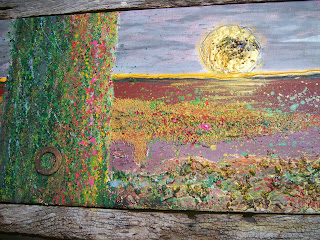.JPG) |
| Chenevaux - The Atelier and our Farmhouse |
Influences include the rationale of the Abstract Impressionist movement in the 1940's, 50's and 60's in America and the Japanese principles of Wabi-Sabi, which are explained in more detail later. They are also based on the local landscape around my home and studio in St Pierre de Maille, France, and the textures, forms and glaze effects on the ceramic artwork I also create in the same studio. I am also inspired by landscapes from further afield, as in the paintings shown below which are based on rock formations on a beach in Australia.
 |
| Rock and Water, Australia, approx 1m x 1m |
 |
| Glazes are also influenced by natural forms |
 |
| Working on this and other paintings below. |
.JPG) |
| This is normally the ceramics workshop. |
 |
 |
| Paint was dropped onto the canvas from the upstairs window of the studio. |
Abstract expressionism is best known for using abstraction ( art that is unconcerned with the literal depiction of things from their visual world ) to convey strong emotional or expressive context often taking the canvas off the easel and using unconventional materials and methods including " action painting " where the process of the painting and an element of chance is as important as the finished piece.
 |
| Working upstairs in the studio. |
Wabi Sabi - Japanese Philosophy of Authenticity. Nothing lasts, nothing is finished, nothing is perfect.
 |
| The frame is made of weathered oak, previously part of an old, discarded door. |
It celebrates cracks, chips, and other marks of time, weather and use. Once we see the beauty in such "deficiencies " we can learn to embrace the flaws - the wrinkles, rust and frayed edges, and all of the imperfections in our lives.
Wabi Sabi is the beauty of aged imperfection. Valuing, not avoiding the process of decay, loving things that show the passage of time, accepting what is slightly flawed.
Wabi - This part is the spiritual essence of tranquility, simplicity and humble freedom.
Sabi - This has to do with time's passage. Weathering, tarnish, rusting, patina. It is about beauty that comes with age.
 |
| Imperfect or quirky? |
I also like to work with Op art and colour theory. Op art (or optical art) is a style of visual art that makes use of optical illusions. Op art works are abstract, often with an impression of movement, hidden images, flashing colours and a vibration of patterns created by sensitive choice of colours, shapes, and in my case projections of coloured light to take the image into a different dimension. We are going to try and create a short video to illustrate the effects.
" Art does not reproduce what we see:
Rather, it makes us see. "
Paul Klee
If you would like any more information about my work please do not hesitate to contact me at judsonsinfrance@wanadoo.fr or call 0033 549913096.
I am always interested in hearing about exhibition opportunities.
Visitors most welcome to the studio - please call or e-mail first to make sure we are here.
.jpg)
No comments:
Post a Comment